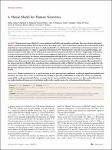A Mouse Model for Human Norovirus
Taube, Stefan
Kolawole, Abimbola O.
Höhne, Marina
Wilkinson, John E.
Handley, Scott A.
Perry, Jeffrey W.
Thackray, Larissa B.
Akkina, Ramesh
Wobus, Christiane E.
Human noroviruses (HuNoVs) cause significant morbidity and mortality worldwide. However, despite substantial efforts, a small-animal model for HuNoV has not been described to date. Since "humanized" mice have been successfully used to study human-tropic pathogens in the past, we challenged BALB/c mice deficient in recombination activation gene (Rag) 1 or 2 and common gamma chain (γc) (Rag-γc) engrafted with human CD34(+) hematopoietic stem cells, nonengrafted siblings, and immunocompetent wild-type controls with pooled stool isolates from patients positive for HuNoV. Surprisingly, both humanized and nonhumanized BALB/c Rag-γc-deficient mice supported replication of a GII.4 strain of HuNoV, as indicated by increased viral loads over input. In contrast, immunocompetent wild-type BALB/c mice were not infected. An intraperitoneal route of infection and the BALB/c genetic background were important for facilitating a subclinical HuNoV infection of Rag-γc-deficient mice. Expression of structural and nonstructural proteins was detected in cells with macrophage-like morphology in the spleens and livers of BALB/c Rag-γc-deficient mice, confirming the ability of HuNoV to replicate in a mouse model. In summary, HuNoV replication in BALB/c Rag-γc-deficient mice is dependent on the immune-deficient status of the host but not on the presence of human immune cells and provides the first genetically manipulable small-animal model for studying HuNoV infection. IMPORTANCE Human noroviruses are a significant cause of viral gastroenteritis worldwide, resulting in significant morbidity and mortality. Antivirals and vaccines are currently not available, in part due to the inability to study these viruses in a genetically manipulable, small-animal model. Herein, we report the first mouse model for human noroviruses. This model will accelerate our understanding of human norovirus biology and provide a useful resource for evaluating antiviral therapies.
No license information
Related Items
Show related Items with similar Title, Author, Creator or Subject.
-
2010-06-24ZeitschriftenartikelChronic norovirus infection after kidney transplantation: molecular evidence for immune-driven viral evolution. Schorn, Robert; Höhne, Marina; Meerbach, Astrid; Bossart, Walter; Wüthrich, Rudolf P.; Schreier, Eckart; Müller, Nicolas J.; Fehr, ThomasBackground: Norovirus infection is the most common cause of acute self-limiting gastroenteritis. Only 3 cases of chronic norovirus infection in adult solid organ transplant recipients have been reported thus far. Methods: ...
-
2008-02-01ZeitschriftenartikelEmergence of new norovirus variants on spring cruise ships and prediction of winter epidemics. Verhoef, Linda; Depoortere, Evelyn; Boxman, Ingeborg; Duizer, Erwin; Duynhoven, Yvonne van; Harris, John; Johnsen, Christina; Kroneman, Annelies; Schreier, EckartIn June 2006, reported outbreaks of norovirus on cruise ships suddenly increased; 43 outbreaks occurred on 13 vessels. All outbreaks investigated manifested person-to-person transmission. Detection of a point source was ...
-
2013-03-21ZeitschriftenartikelEpidemiology of norovirus gastroenteritis in Germany 2001-2009: eight seasons of routine surveillance Bernard, Helen; Höhne, Marina; Niendorf, Sandra; Altmann, Doris; Stark, KlausWe analysed data on laboratory or epidemiologically confirmed cases (n = 856,539) and on outbreaks (n = 31,644) notified during week 31 (2001) to week 30 (2009), and performed molecular typing of specimens from 665 outbreaks. ...

